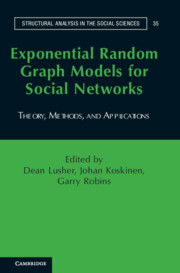Book contents
- Frontmatter
- Contents
- List of Figures
- List of Tables
- 1 Introduction
- Section I Rationale
- Section II Methods
- 6 Exponential Random Graph Model Fundamentals
- 7 Dependence Graphs and Sufficient Statistics
- 8 Social Selection, Dyadic Covariates, and Geospatial Effects
- 9 Autologistic Actor Attribute Models
- 10 Exponential Random Graph Model Extensions: Models for Multiple Networks and Bipartite Networks
- 11 Longitudinal Models
- 12 Simulation, Estimation, and Goodness of Fit
- 13 Illustrations: Simulation, Estimation, and Goodness of Fit
- Section III Applications
- Section IV Future
- References
- Index
- Name Index
13 - Illustrations: Simulation, Estimation, and Goodness of Fit
Published online by Cambridge University Press: 05 April 2013
- Frontmatter
- Contents
- List of Figures
- List of Tables
- 1 Introduction
- Section I Rationale
- Section II Methods
- 6 Exponential Random Graph Model Fundamentals
- 7 Dependence Graphs and Sufficient Statistics
- 8 Social Selection, Dyadic Covariates, and Geospatial Effects
- 9 Autologistic Actor Attribute Models
- 10 Exponential Random Graph Model Extensions: Models for Multiple Networks and Bipartite Networks
- 11 Longitudinal Models
- 12 Simulation, Estimation, and Goodness of Fit
- 13 Illustrations: Simulation, Estimation, and Goodness of Fit
- Section III Applications
- Section IV Future
- References
- Index
- Name Index
Summary
Chapter 12 introduces simulation of exponential random graph models (ERGMs) and shows how simulation could be used as a heuristic method of goodness of fit (GOF) to see whether a model can fit many features of an empirical network. In this chapter, we provide some specific examples, including some short simulation studies and a GOF analysis for models for The Corporation communication network first introduced in Chapter 5. The goals of this chapter are straightforward:
Through simulation, we illustrate the effects of different parameters and show how they can work together. This can assist with model interpretation.
We make some practical suggestions about model specification based on our own experience of fitting models.
With a simplified GOF example, we show how GOF may guide model selection, so that effects may be added to a simpler model in order to improve fit.
These illustrations can be replicated by interested readers who want to gain direct exposure in these procedures and experience in handling ERGMs using PNet.
Simulation
We begin with a series of simple simulations to make some points about parameters and their interpretations. We typically demonstrate the simulations by visualizing an individual graph from the distribution; however, once a simulation has burnt in, it is possible to take a sample of graphs and examine their general properties, including means and standard deviations (SDs) of relevant graph statistics. Throughout, we choose networks with thirty nodes and simulate according to the procedure in Section 12.2.2 with a burn-in of 100,000 iterations. After the burn-in, we simulate for 1 million iterations. When we extract a sample, we will take 1,000 graphs (i.e., every 1,000th graph of 1 million iterations). A visualization will be the last graph in the simulation. Readers who want to reproduce these simulations need to realize, of course, that because we only have a sample of graphs from the distribution, their results may differ slightly from those reported here. Nevertheless, they should be broadly consistent within the natural variation described by SDs.
- Type
- Chapter
- Information
- Exponential Random Graph Models for Social NetworksTheory, Methods, and Applications, pp. 167 - 186Publisher: Cambridge University PressPrint publication year: 2012
- 7
- Cited by

